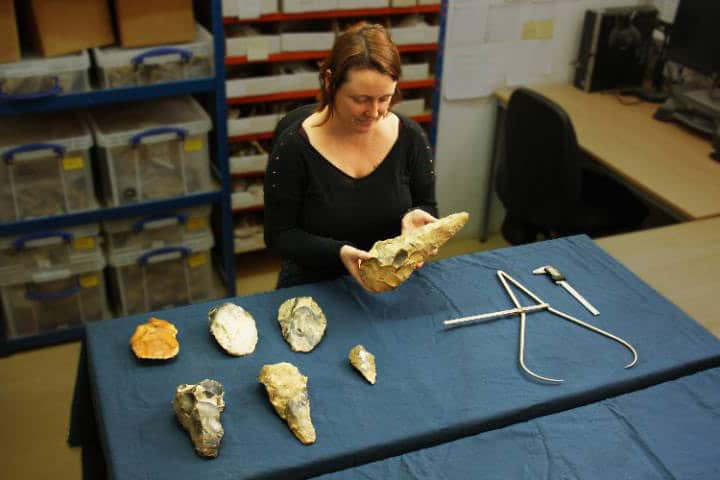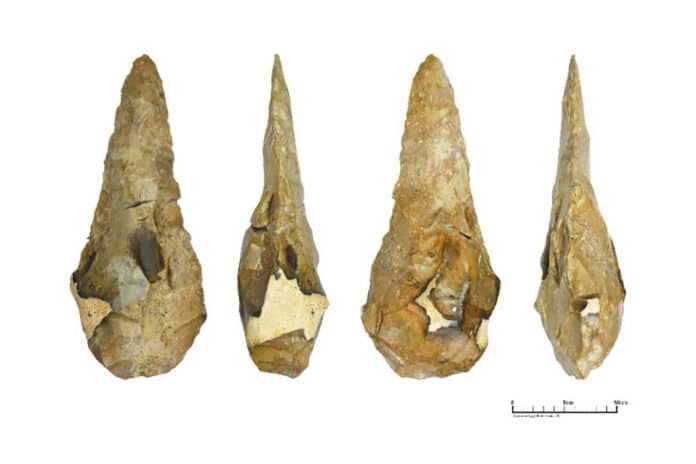Buried in sediments that filled a sinkhole and ancient river channel, over 800 stone artifacts were discovered during excavations in Kent. The artifacts are believed to be more than 300,000 years old.
The discovery, by researchers from UCL Archaeology South-East, revealed prehistoric artifacts in deep Ice Age sediments preserved on a hillside above the Medway Valley.
Two large flint knives, called “giant handaxes,” were discovered among the artifacts. Handaxes are stone artifacts with long cutting edges that have been symmetrically shaped after being chipped, or “knapped,” on both sides. According to researchers, this equipment was typically carried in hand and may have been used for butchering and chopping animal meat. The two biggest handaxes discovered at the Maritime site have an unusual design with a long, beautifully crafted tip and a thicker base.
Senior Archaeologist Letty Ingrey (UCL Institute of Archaeology) said: “We describe these tools as ‘giants’ when they are over 22cm long, and we have two in this size range. The biggest, a colossal 29.5cm in length, is one of the longest ever found in Britain. ‘Giant handaxes’ like this are usually found in the Thames and Medway regions and date from over 300,000 years ago.”
“These handaxes are so big it’s difficult to imagine how they could have been easily held and used. They may have fulfilled a less practical or more symbolic function than other tools, a clear demonstration of strength and skill. While we aren’t sure why such large tools were being made or which species of early humans were making them, this site offers a chance to answer these exciting questions.”
The site is believed to have existed during the early prehistory of Britain, when Neanderthal cultures began forming, and other early human species may have possibly coexisted in the area. At that time, the Medway Valley would have been a wild region of forested hills and river valleys, home to less common creatures, including the now-extinct straight-tusked elephant and lion, as well as red deer and horses.

Although this age’s archaeological artifacts, including another magnificent “giant” handaxe, have previously been discovered in the Medway Valley, this is the first time they have been discovered as part of a significant excavation, providing the opportunity to learn more about the lives of its creators.
Dr. Matt Pope (UCL Institute of Archaeology) said: “The excavations at the Maritime Academy have given us a precious opportunity to study how an entire Ice Age landscape developed over a quarter of a million years ago. A scientific analysis program involving specialists from UCL and other UK institutions will help us understand why the site was important to ancient people and how the stone artifacts, including the ‘giant handaxes,’ helped them adapt to the challenges of the Ice Age environments.”
Scientists are now working on identifying and studying the recovered artifacts to understand better who created them and what they were used for.
The excavation of a Roman cemetery, which dates to at least a quarter of a million years after the Ice Age activity, is led by Senior Archaeologist Giles Dawkes (UCL Institute of Archaeology). The individuals interred here between the first and fourth century AD may have been residents of a nearby villa, which is thought to have been located some 850 meters to the south.
Twenty-five people’s remains were discovered by the team, 13 of which were incinerated. Four people were buried in wooden coffins, while nine of the bodies were discovered carrying commodities or personal objects like bracelets. Pottery collections and animal remains discovered nearby probably refer to feasting customs at the time of burial.
Although cemeteries have historically received less attention from archaeologists than Roman buildings and structures, the discovery of this site may provide fresh information about the burial practices and traditions of both the Romans who lived at the villa and those in the nearby town of Rochester.
Journal Reference:
- Ingrey, L., Duffy, SM., Bates, M., Shaw, A. and Pope, M. 2023 On the Discovery of a Late Acheulean’ Giant’ Handaxe from the Maritime Academy, Frindsbury, Kent, Internet Archaeology 61. DOI: 10.11141/ia.61.6
